Explore the Wonders of Natural History
Unveiling Nature's Greatest Stories
Discover the captivating tales and groundbreaking discoveries that have shaped our understanding of the natural world.
The Allure of Natural History
A Journey Through Time and Nature
Natural history offers a window into the past, revealing the intricate tapestry of life that has evolved over millions of years. From the majestic dinosaurs that once roamed the Earth to the delicate ecosystems that thrive today, each chapter of natural history is a testament to the resilience and diversity of life. Join us as we delve into the wonders of the natural world, where every fossil, every species, and every landscape tells a story of survival, adaptation, and beauty.

Top Ten Fascinating Facts in Natural History
- The discovery of the first dinosaur fossil in 1824 revolutionized our understanding of prehistoric life.
- The extinction of the dodo bird in the late 17th century highlighted the impact of human activity on species survival.
- The Great Oxygenation Event, occurring around 2.4 billion years ago, transformed Earth’s atmosphere and enabled complex life to flourish.
- The unearthing of the Burgess Shale fossils provided a glimpse into the Cambrian Explosion, a pivotal period of evolutionary development.
- The theory of continental drift, proposed by Alfred Wegener, reshaped our understanding of Earth’s geological history.
- The discovery of the coelacanth, a ‘living fossil,’ challenged assumptions about species extinction and survival.
- The Ice Age, with its massive glaciers, sculpted the landscapes we see today and influenced the evolution of many species.
- The emergence of flowering plants during the Cretaceous period led to a dramatic diversification of life on Earth.
- The asteroid impact that caused the Cretaceous-Paleogene extinction event paved the way for the rise of mammals.
- The discovery of Lucy, a 3.2-million-year-old hominid skeleton, provided crucial insights into human evolution.
- The discovery of the first dinosaur fossil in 1824 revolutionized our understanding of prehistoric life.
- The extinction of the dodo bird in the late 17th century highlighted the impact of human activity on species survival.
- The Great Oxygenation Event, occurring around 2.4 billion years ago, transformed Earth’s atmosphere and enabled complex life to flourish.
- The unearthing of the Burgess Shale fossils provided a glimpse into the Cambrian Explosion, a pivotal period of evolutionary development.
- The theory of continental drift, proposed by Alfred Wegener, reshaped our understanding of Earth’s geological history.
- The discovery of the coelacanth, a ‘living fossil,’ challenged assumptions about species extinction and survival.
- The Ice Age, with its massive glaciers, sculpted the landscapes we see today and influenced the evolution of many species.
- The emergence of flowering plants during the Cretaceous period led to a dramatic diversification of life on Earth.
- The asteroid impact that caused the Cretaceous-Paleogene extinction event paved the way for the rise of mammals.
- The discovery of Lucy, a 3.2-million-year-old hominid skeleton, provided crucial insights into human evolution.
- The discovery of the first dinosaur fossil in 1824 revolutionized our understanding of prehistoric life.
- The extinction of the dodo bird in the late 17th century highlighted the impact of human activity on species survival.
- The Great Oxygenation Event, occurring around 2.4 billion years ago, transformed Earth’s atmosphere and enabled complex life to flourish.
- The unearthing of the Burgess Shale fossils provided a glimpse into the Cambrian Explosion, a pivotal period of evolutionary development.
- The theory of continental drift, proposed by Alfred Wegener, reshaped our understanding of Earth’s geological history.
- The discovery of the coelacanth, a ‘living fossil,’ challenged assumptions about species extinction and survival.
- The Ice Age, with its massive glaciers, sculpted the landscapes we see today and influenced the evolution of many species.
- The emergence of flowering plants during the Cretaceous period led to a dramatic diversification of life on Earth.
- The asteroid impact that caused the Cretaceous-Paleogene extinction event paved the way for the rise of mammals.
- The discovery of Lucy, a 3.2-million-year-old hominid skeleton, provided crucial insights into human evolution.
Explore the Wonders of Natural History
Join us on a visual journey through the most awe-inspiring moments in natural history. From the dawn of life on Earth to the rise of the dinosaurs and beyond, this video captures the essence of our planet’s incredible past.
What Our Readers Are Saying
★★★★★
“Top Ten’s natural history lists are a treasure trove of fascinating insights. I always learn something new!”

Alex Johnson
History Enthusiast
★★★★★
“The engaging content and beautiful visuals make exploring natural history a delightful experience. Highly recommended!”

Emily Carter
Nature Lover
Dive Deeper into Natural History
Hello world!
Welcome to WordPress. This is your first post. Edit or delete it, then start writing!
Hello world!
Welcome to WordPress. This is your first post. Edit or delete it, then start writing!
